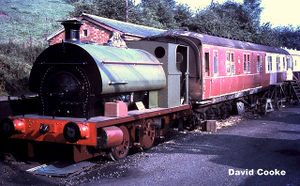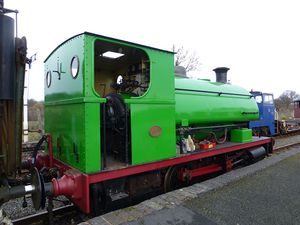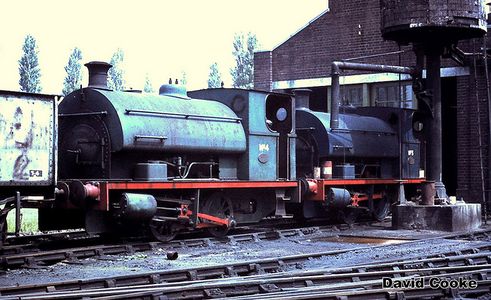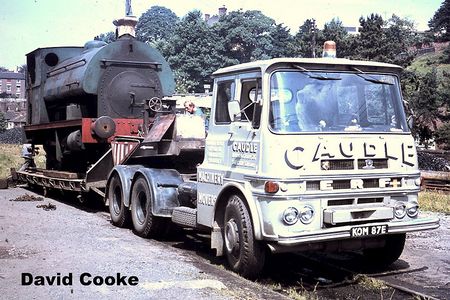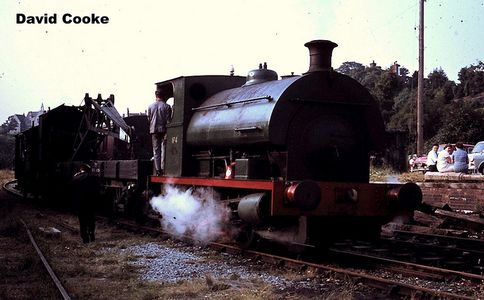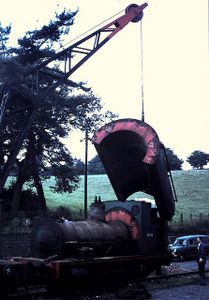Peckett 1738 was resident on the SVR between 1968 and 1995, and returned as a Gala visitor in October 2000.
Contents
Service
Peckett and Sons of Bristol produced more than 50 of their W5 class 0-4-0ST locomotives between 1926 and 1940, of which more than half were still in existence as late as 1968. This particular locomotive was built as Works No 1738 of 1928 to the order of the City of Birmingham Electricity Service and delivered in July of that year to their Hams Hall Power Station at Coleshill, near Birmingham. An identical W5 class Peckett had been delivered there a few months earlier.[1]
The locomotives' main duties at Hams Hall were shunting coal wagons between the exchange sidings on the LMS line and the power station. As the power station grew, larger and more powerful locomotives were obtained and by the 1960s the Pecketts were relegated to lighter duties and eventually stored out of use, with much of the traffic being worked by more modern diesel locomotives.[1]
In early 1968 seven steam locomotives at Hams Hall were declared surplus to requirements by the CEGB and offered for sale by tender, of which 1738 (CEGB No 4) was considered in the best condition.
Preservation
By mid-1968 the Severn Valley Railway Society had established a presence at Bridgnorth and the first five steam locomotives had arrived,[note 1] although opening to Hampton Loade was still several years off. 1738 was purchased by SVR member Jim McNally who was already one of the SVR's drivers at the time, and was intended for stock shunting at Bridgnorth without the need to raise steam in one of the larger locomotives[2] (all shunting at that time was by steam locomotives as the first diesel shunter did not arrive until 1971).
1738 arrived at Bridgnorth by road on Saturday 13 July 1968 and was steamed shortly after arrival. Concerns that it would be too small for use were allayed when it was found "possible to shunt in Bridgnorth Yard at 2 hours' notice with a few shovelfuls of coal".[1] It was used on shunting duties for the rest of the year and also gave footplate rides during the August 1968 Gala.[2]
1738 was steamed again in 1969[3], although the nature of its role at Bridgnorth meant that only 2 miles of use had been recorded when the locomotive was withdrawn for a major overhaul. By mid-1970 it had been dismantled and was "in the midst of major restoration" at Bridgnorth[4] On 30 June 1973 it had been steam tested and was turned to face north using a hired crane, before being finished in GWR livery. It was steamed twice in 1973, although only for working around Bridgnorth yard.[5] In September 1975 1738 was again recorded as undergoing a major overhaul, requiring a set of new tubes to be fitted. It was expected to re-enter traffic at some time in 1976, probably for shunting at Bewdley.[6] However no further reports appeared in SVR News until the locomotive returned to traffic in September 1984.[7] It was used at Bewdley during the April 1985 Enthusiast Weekend[8] but saw little use thereafter. By winter 1991 it was again out of use having accumulated a total of just 14 miles in service, and in spring 1994 SVR News reported that "Anyone interested should contact Jim McNally, the owner".[9] It eventually left the SVR circa November 1995, moving to the South Devon Railway.
1738 made a return visit to the SVR for a ‘Thomas’ weekend in October 2000, appearing as ‘Percy’ alongside LMS Jinty 47383 as ‘Thomas’.[10]
Around 2005 the locomotive was taken into private ownership at Titley Junction Station in Herefordshire,[11] where it was still used as ‘Percy’ from time to time as seen in the 2013 photograph. The Kingfisher Line and Titley Junction Station are privately owned and entry to the public is strictly forbidden. The former website is archived but in 2018 the line was still extant: a 'Steam and and Tea Afternoon' was organised on 18 August with a steam train ride.[12][13] The present status of 1738 is however unclear.
Sister locomotives
One other W5 class Peckett survives in preservation at the Appleby-Frodingham RPS, Works no 1438 of 1916 ex-CEGB, Nechells Power Station, Birmingham. The article in SVR News 10 suggested that several of the class worked at the power stations at Ironbridge and Stourport on the Severn Valley Branch. However the three preserved examples which saw service there are the later W6 class which shared the same wheelbase, wheel diameter and cylinder dimensions but was slightly longer, wider in the boiler, tank and cab, and was not fitted with smokebox wing plates[14].
Gallery
See also
Notes
- ↑ GWR 3205, LMS 46443, MW 2047, GWR 813 and LMS 47383
References
Links
| ||||||||||||||||||||||||||||||||||
